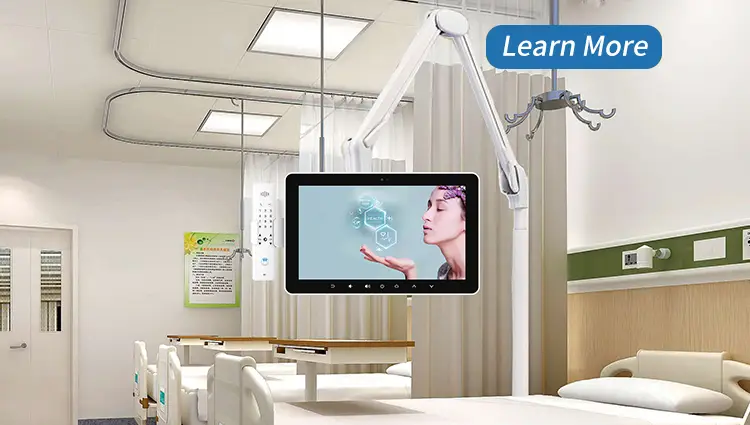Understanding Bedside Integrated Terminals
Imagine a hospital room where patients can access their health data, communicate with medical staff, and even enjoy entertainment—all from a single, intuitive device. That’s what a bedside integrated terminal (BIT) offers. These systems combine monitoring, data management, and patient engagement into one streamlined unit, making hospital stays smoother for both patients and staff.
Why Hospitals Are Investing in Bedside Technology
Hospitals are increasingly adopting bedside terminals because they provide real-time data, reduce errors, and improve patient satisfaction. As healthcare moves toward digital transformation, integrating technology directly at the bedside has become a game-changer.

Core Functions of Bedside Integrated Terminals
Patient Monitoring and Real-Time Data Collection
Vital Signs Tracking
Bedside terminals constantly monitor vital signs like heart rate, blood pressure, and oxygen levels. This ensures that any sudden changes in a patient’s condition trigger immediate alerts.
Alerts and Notifications for Medical Staff
When critical thresholds are reached, bedside terminals send instant notifications to nurses and doctors, enabling rapid response and potentially saving lives.
Electronic Medical Record (EMR) Access
Seamless Data Input and Retrieval
These terminals integrate directly with EMR systems, allowing healthcare providers to update patient records instantly. This eliminates manual paperwork and improves record accuracy.
Patient Engagement and Entertainment
Communication with Care Teams
Patients can send messages to their care teams, request assistance, and receive updates on their treatment—all from the bedside terminal.
Entertainment Options for Patients
Long hospital stays can be tedious, but bedside terminals provide movies, music, and games, helping reduce stress and improve overall patient experience.
Medication and Treatment Management
Automated Medication Reminders
Bedside terminals can alert patients when it’s time to take medication, reducing the risk of missed doses and improving treatment adherence.
Integration with Hospital Systems
They connect with pharmacy and treatment systems to ensure accurate medication administration and streamline workflows.
Advantages of Bedside Integrated Terminals
Enhanced Patient Care
Patients receive real-time monitoring and timely intervention, which can lead to faster recovery and fewer complications.
Increased Efficiency for Medical Staff
By automating routine tasks and providing instant access to data, bedside terminals free up staff to focus on critical patient care.
Improved Accuracy and Reduced Errors
Direct integration with EMR systems reduces transcription errors and ensures that patient information is always up-to-date.
Data-Driven Decision Making
With access to comprehensive patient data, clinicians can make informed decisions that improve outcomes.
Cost Efficiency in the Long Term
While initial investments may be high, hospitals save money over time by reducing errors, improving staff efficiency, and shortening patient stays.

Technology Behind Bedside Integrated Terminals
Hardware Components
Touchscreen Displays and Rugged Devices
High-resolution touchscreens allow intuitive interaction, and rugged designs ensure durability in busy hospital environments.
Sensors and IoT Connectivity
Embedded sensors monitor vital signs, while IoT connectivity enables real-time data sharing across hospital networks.
Software Components
EMR Software Integration
BITs are compatible with EMR platforms, making data entry seamless and accurate.
AI and Analytics Capabilities
Advanced systems can analyze trends in patient data, providing predictive insights that help prevent complications.
Network and Security Considerations
Secure Data Transmission
All patient data is encrypted, ensuring privacy during transmission between devices and servers.
Compliance with HIPAA and Other Regulations
Bedside terminals comply with healthcare regulations, safeguarding sensitive patient information.
Implementation Considerations
Staff Training and Adoption
Staff must be trained to use these systems efficiently. Hospitals often implement phased rollouts to ensure smooth adoption.
System Integration with Existing Hospital Infrastructure
Seamless integration with existing hospital networks and EMR systems is critical to avoid workflow disruptions.
Maintenance and Technical Support
Regular maintenance and responsive technical support prevent downtime and ensure optimal performance.
Patient Privacy and Data Security
Strict protocols must be in place to protect patient data and comply with privacy regulations.
The Future of Bedside Integrated Terminals
AI-Driven Personalized Patient Care
Future terminals will leverage AI to tailor treatment plans and alerts based on individual patient needs.
Remote Monitoring and Telemedicine Integration
Integration with telemedicine platforms allows doctors to monitor patients remotely, extending care beyond hospital walls.
Predictive Analytics for Better Outcomes
Predictive algorithms will anticipate complications before they happen, enhancing proactive care.
Expansion to Home Healthcare Settings
Bedside terminal technology may soon be adapted for home use, allowing patients to receive hospital-grade monitoring and support at home.

Conclusion
Bedside integrated terminals represent a significant leap forward in healthcare technology. By combining monitoring, communication, and entertainment into a single platform, they enhance patient care, streamline workflows, and support data-driven decision-making. As technology evolves, these systems will continue to expand their impact—both in hospitals and potentially in home healthcare settings.
FAQs
What is the main purpose of a bedside integrated terminal?
The main purpose is to streamline patient monitoring, data management, and communication between patients and healthcare providers.
How does it improve patient care?
It provides real-time monitoring, timely alerts, and access to medical records, which helps prevent errors and improves treatment outcomes.
Can these systems integrate with existing EMR software?
Yes, most bedside integrated terminals are designed to integrate seamlessly with EMR platforms to ensure accurate and updated patient information.
Are bedside terminals secure for patient data?
Absolutely. They use encrypted data transmission and comply with privacy regulations like HIPAA.
What does the future hold for bedside integrated terminals?
The future includes AI-driven personalized care, predictive analytics, telemedicine integration, and potential expansion into home healthcare.

